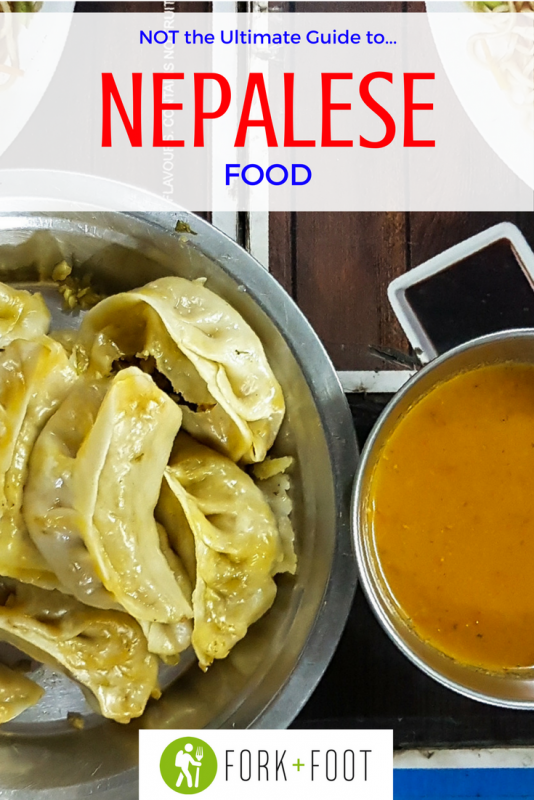Nepalese food doesn’t get a lot attention in the western world. But as you’ll see, it’s a very important part of Nepali culture – and this guide to Nepalese food will get your foodie adventures off to the perfect start!
If I was to ask you about your favourite Nepalese food, what would you say?
Would you be like me and pause, rack your brain, and come up with nothing?
Crouching in the shadow of its larger southern sibling India, Nepalese food goes largely unrecognised by much of the world. And until four weeks ago, I was no different.
Incorrectly, but like many others, I assumed it would be the same as Indian. Yet as you’ll see, it is so much more than that, with strong influences from Tibet, south east asia, and most importantly from within Nepal itself.
Along the way I’ve also discovered one of the world’s best street foods…why it isn’t more popular outside Nepal, I have no idea, but it’s destined for big things!

Street Stall
Nepalese food – What’s the story?
I loved geography in school. Mountains, rivers, oceans…lazy summer afternoons would often find me on my stomach in my bedroom, poring over my Macquarie World Atlas and tracing borders just for the fun of it!
History? Not so much.
Yet, to understand the cuisine of this small nation a little bit of both is needed. Bear with me, I’ll keep it to a minimum 😀
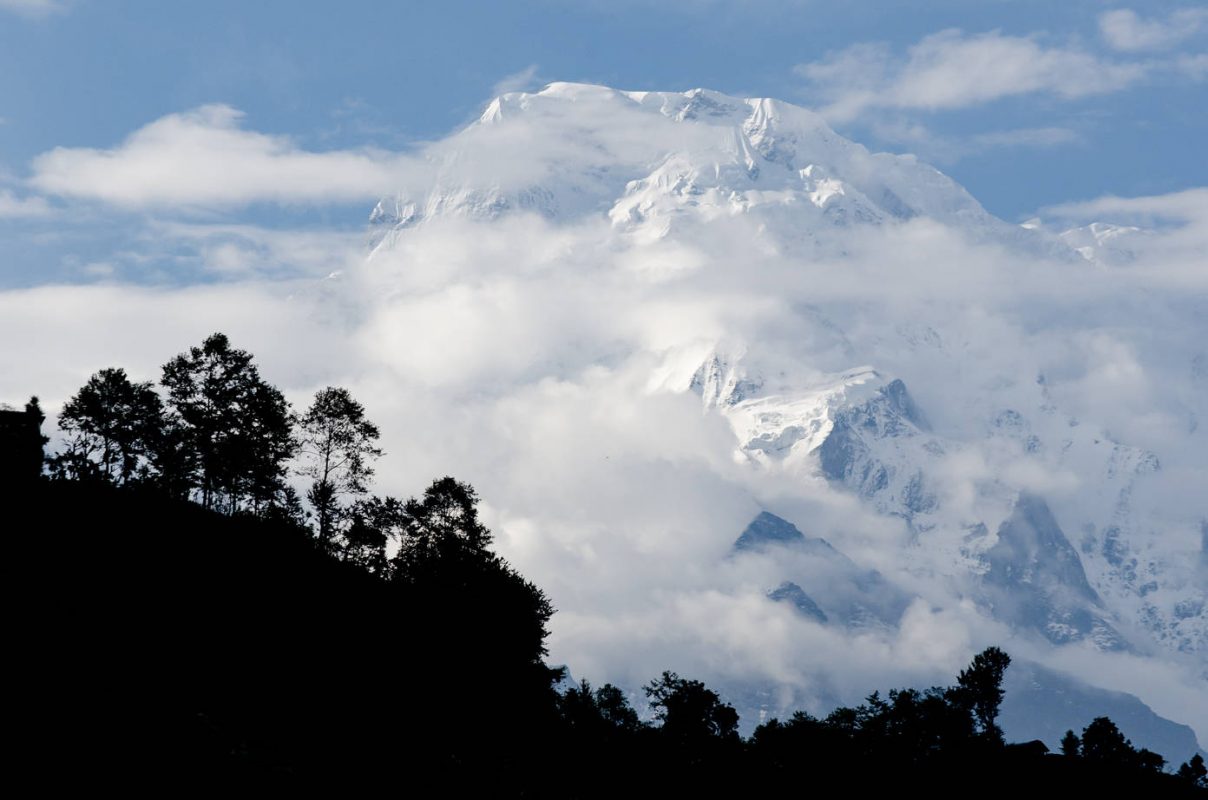
Annapurna South
If there’s one thing about Nepal we’ve ALL heard of, it’s the Himalayas! A towering chain of mountains arcing more than 2,400km from Pakistan through Nepal and Bhutan, to far eastern India. K2, Lhotse, Manaslu, and of course Mt Everest are some of its highest peaks, soaring above 8,000m and forming the world’s most un-neighbourly fence between Nepal and its northern neighbour, Tibet (now China).
On the Tibetan side of the fence, high on the freezing Tibetan Plateau they have salt, historically an extremely valuable commodity. Even now, if you look hard enough you’ll see a grinder full of ‘Himalayan Salt’ on the shelf of your local supermarket. You never needed that kidney, did you?
On the Nepalese side? Rice from the hot, low-lying Terai plains (yes, Nepal has plains!!), and a gateway to India.
Naturally, trade routes were established between these regions through the mountain passes, and so began centuries of an interweaving of cultures, religion and cuisine.

Night Market
Another Nepalese oddity is that until the late 1940s it had essentially closed its borders to international travellers.
With WWII finished, many Gurkha fighters had returned home with stories of the west, India was moving towards inevitable independence and the removal of the British colonial power, and China was in the throes of the communist revolution. All conspired to bring the Nepalese to the realisation that they needed to end their isolationist tendencies lest they be crushed in the surrounding political mayhem!
Those closed borders weren’t so great for tourism, but one really interesting and positive outcome was the protection of traditional Nepalese food from foreign influence.
While all manner of western food can be found in Kathmandu or Pokhara, it still isn’t prevalent (thank goodness!), and you don’t need to travel far to see that traditional food is still the staple for most Nepali.

Fruit Seller
I spent nearly two weeks in Nepal, with my time spent between its capital Kathmandu, the gorgeous lakeside city of Pokhara, ‘Gateway to the Himalaya’, and with the Gurung people of the Kaski district as I explored the Himalaya by foot.
Unlike most of our travels abroad, I hadn’t planned a food itinerary for Nepal. Despite this, it still emerged as one of the most exciting aspects of my time in this fascinating country, and it opened my eyes to what much of the western world is missing!
So, in my very best effort to turn that around, here are 5 Nepalese dishes (and some beverages) that I discovered in my travels and that I encourage you to try, whether it’s in your local Nepalese restaurant or if you have the privilege of travelling to Nepal itself!
Samosa chaat

Samosa Chaat Street Stall
I’d been in Nepal less than half a day and already I was wandering Kathmandu’s manic streets trying to find some lunch.
Actually, scratch that. Manic is an understatement.
The dirt, the cacophony of sounds, the aromas both sweet and odious…I’m a seasoned traveller and yet this felt like an assault from all sides!
In an effort to escape the searing heat and throat clogging dust I was looking for an indoor lunch option, but got distracted by this lovely gentleman serving up colourful dishes of ‘samosa chaat’.
If you peruse your local Indian restaurant’s menu you’re guaranteed to see samosas on there…fried pyramids of wheat flour, often filled with potatoes and other vegetables.
I can’t speak Hindi, but having spoken with a Nepalese friend I’ve been assured that ‘chaat’ can be translated to ‘A little bit of everything’. When you consider what goes into the mixture it makes more than a little bit of sense.
Yoghurt is the base of the sauce, with chickpeas, ginger, coriander, chili and who knows what else thrown in!
Break up a few samosas and stir them through for both flavour and texture and you’ve got yourself one seriously tasty meal (curious bystanders included), and all for less than a dollar!

Bowl of Samosa Chaat
My biggest worry was whether my stomach could handle such an abrupt change in diet to Nepalese food, particularly as I was about to leave for our hiking adventure the following day. But no, my instincts held me in good stead once again and my fellow hikers were safe 😀
Dal-bhat-tarkari

Dal-Bhat
No visit to Nepal can be considered complete if you haven’t tried the dal-bhat-tarkari. In fact, by the time you’re two days into your travels there’s every chance you may have been offered this dish more than half a dozen times already!
Degustations are all the rage back home, and yet this is how the Nepalese have been eating for centuries. The rice (bhat) is lumped in the middle of your plate, and then lentil soup (dal), vegetable curry (tarkari) and other tasty dishes like pickled vegetables, meat in a curry or yoghurt sauce, and spicy achaar sauce are placed in small dishes around the perimeter. Mix it all together like a local and use your right hand to shovel it into your mouth, or try each separately with a fork like a tourist; it doesn’t matter, you’ll love it either way.

Dal-Bhat
If you can, try and hunt down the version from, or in, the Thakali region. This region is located between the lowlands and highlands, and so they have historically been best positioned to combine all ingredients from across Nepal into the dal-bhat-tarkari with the greatest skill.
It is iconic, it is delicious, and it’s the perfect fuel for any aspiring trekker. In fact, poke your head into any t-shirt shop in Nepal and you’ll be bound to spot one with “Dal-bhat power, 24 hour!!” emblazoned across the front!
I lost count of how many dal-bhat’s I tried in Nepal, but the most memorable was from the small town of Panauti, about an hour’s drive to the east of Kathmandu.

Dal-Bhat
Our tour group had finished exploring the town, and in pairs we were hosted by families across the town for lunch (part of the awesome venture Community Homestay). It was simple, and a little rough around the edges compared to some of the lavish spreads we saw in restaurants, but the fresh ingredients, and both the unrestrained pride and undeniable talent of our host made for one very special dal-bhat!
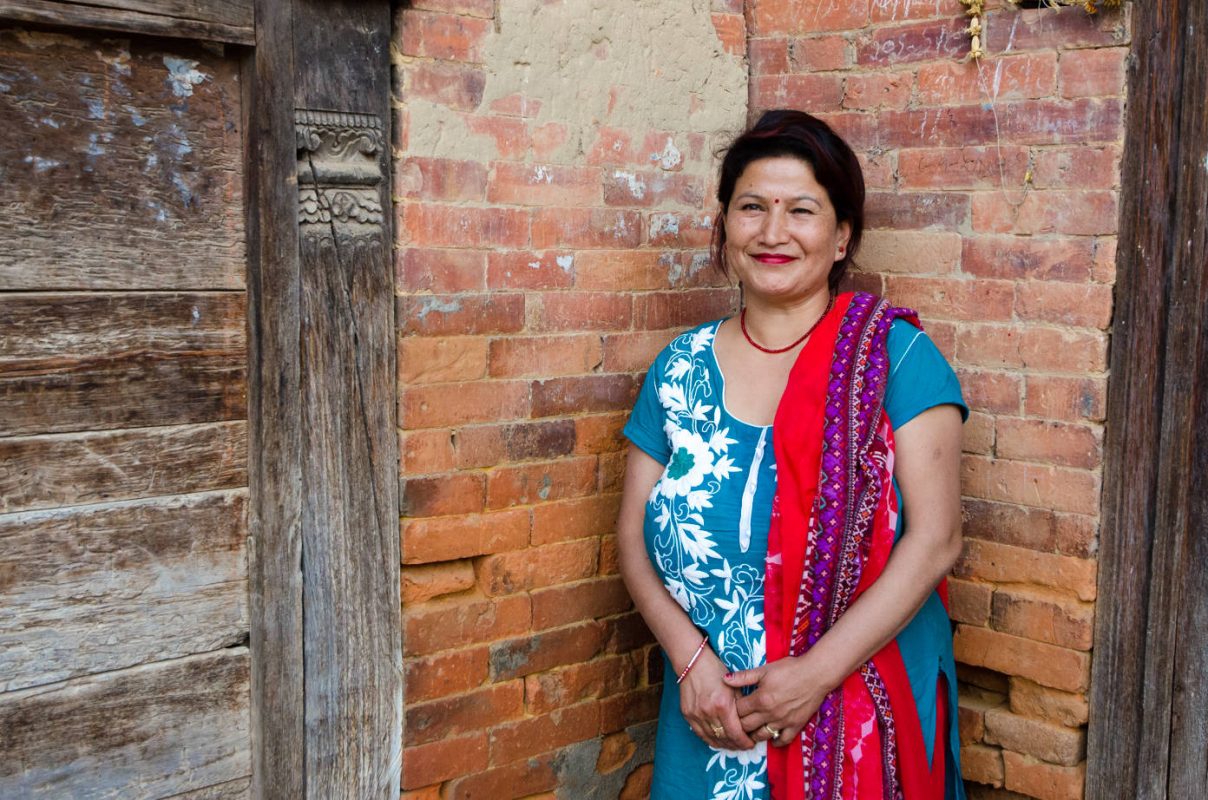
Our Homestay Host
Gurung bread
One of the highlights of hiking the Ghandruk Loop was the opportunity to see how the local Gurung caste lived their everyday lives; tilling the soil, caring for their animals, and looking out for each other in a swiftly changing environment.
It was on the final morning of our hike that I thought to put in an order for some Gurung bread. My only regret was waiting so long!

Gurung Bread
Its other name, Tibetan flatbread, betrays its origins across the border to the north. But for me, this lightly fried pocket of bread took me back to the early morning streets of Hong Kong. A steaming hot bowl of congee front and centre, with a baseball bat of fried youtiao the perfectly edible spoon!
In this instance it was an omelette rather than congee, but I finished my breakfast feeling just as satisfied, yet slightly peeved at all the missed opportunities.
Sel roti

Sel Roti (you can even tell that my eyes had glazed over)
Dough and super-hot oil. You can’t go wrong can you?
The difference with sel roti though is that the dough is made from rice flour instead of wheat. This lends a firmer texture, almost chewy, and a lot more savoury than what we’re used to in a traditional western doughnut.
Nothing a generous dusting of icing sugar can’t fix!
While these are often cooked in bulk and stored for weeks at a time, they are best savoured fresh out of the pan. They cost only cents each and it only takes a few to fill you up. So keep an eye out as you wander the streets of Kathmandu and you’ll have yourself the perfect little snack or breakfast to go!
Mo:Mo

Mo:Mos
This may sound a little bit weird, but one of the biggest reasons why we love travelling so much is for the sense of culture shock that we get in a new country. Equal parts terrifying and exhilarating! It’s part of the reason why London was such a disappointment to us both, and it’s why we still dream of Japan.
Yet, as with any vice, the more of it you have, the harder it is to get that same ‘hit’. You run the risk of needing something stranger, more extreme, even less comprehensible.
But then, every once in a while, you get surprised.
For me this was the Mo:Mo.
You can hardly say it’s a unique dish. China has their baozi, the Poles their pierogi. Russians have pelmeni and the Koreans love their mandu. Whichever variety you grew up with, dumplings are a favourite for millions.
Yet despite its ubiquity, every nation puts its own spin on things, and that’s what makes them so much fun to try! The type of flour used in the wrapper, the technique for folding the outer layer, the flavour of the filling…so many options!
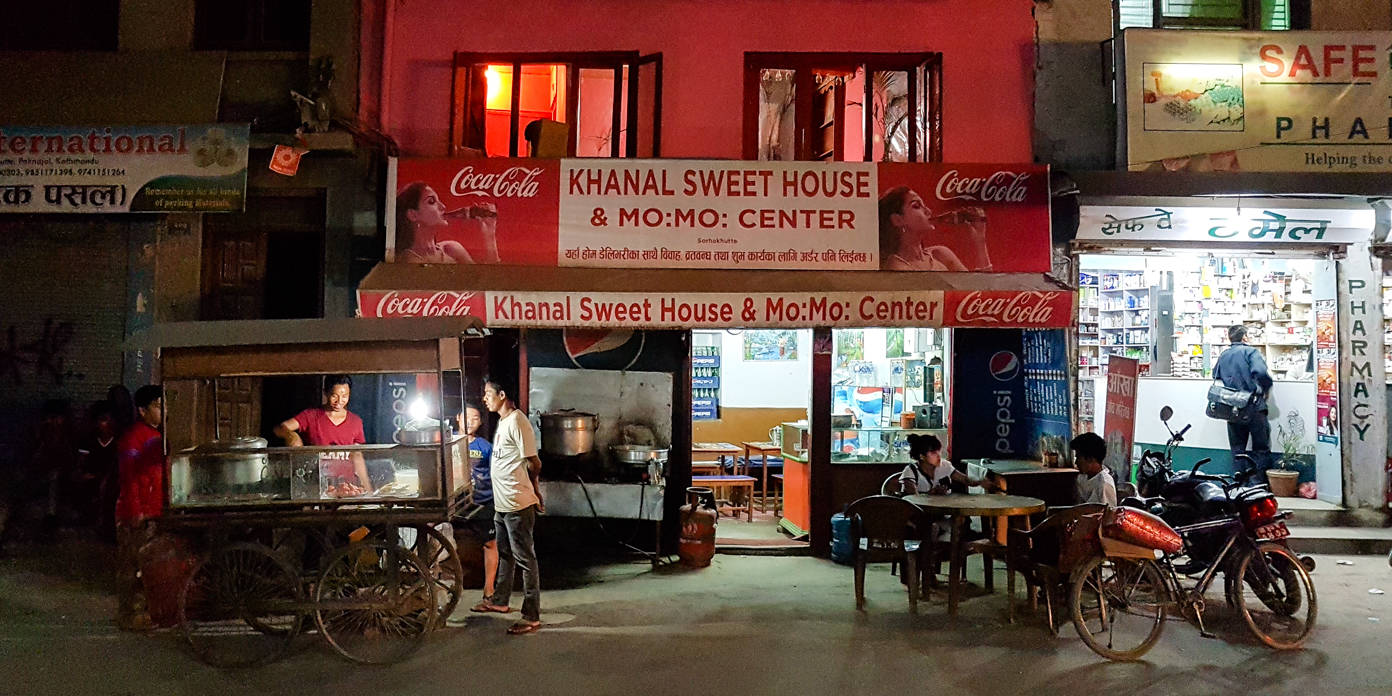
Mo:Mo Restaurant
Yet knowing about them, and being able to successfully track them down in a city like Kathmandu is not as easy as it sounds. I hadn’t done a lot of prep, but one thing I HAD done was track down three or four Mo:Mo venues that seemed to be getting some love, and mark them on Google Maps. It wasn’t a precise science, with street names and numbers a rarity. Instead, I had to get my CSI on and note down every ‘next to…’, ‘across from…’, or ‘down the road from…’.
On my first attempt I stepped out of the taxi with immense confidence that Mo:Mo’s and a full stomach were but minutes away. After wandering Kathmandu’s labyrinthine alleyways for what seemed like hours, desperately trying not to look like a screen-fixated zombie relic of the Pokemon Go era… I admitted defeat.
My second attempt didn’t fare much better, despite the directions being checked and triple checked before leaving the hotel room. The worst thing was, I wasn’t by myself this time! I’d promised much, and delivered nothing.
Thankfully, the owner of the shuttered Mo:Mo shop was kind enough to point us down the road to a smaller venue that was still trading.
YES!!!!
There were two varieties on offer; vegetable, and buffalo (chicken is normally an option as well).
Buffalo, or ‘buff’ as they call it, may be surprising, but it makes sense when you realise that much of the population is Hindu, and cows are considered sacred. So, buffalo is the next best thing!
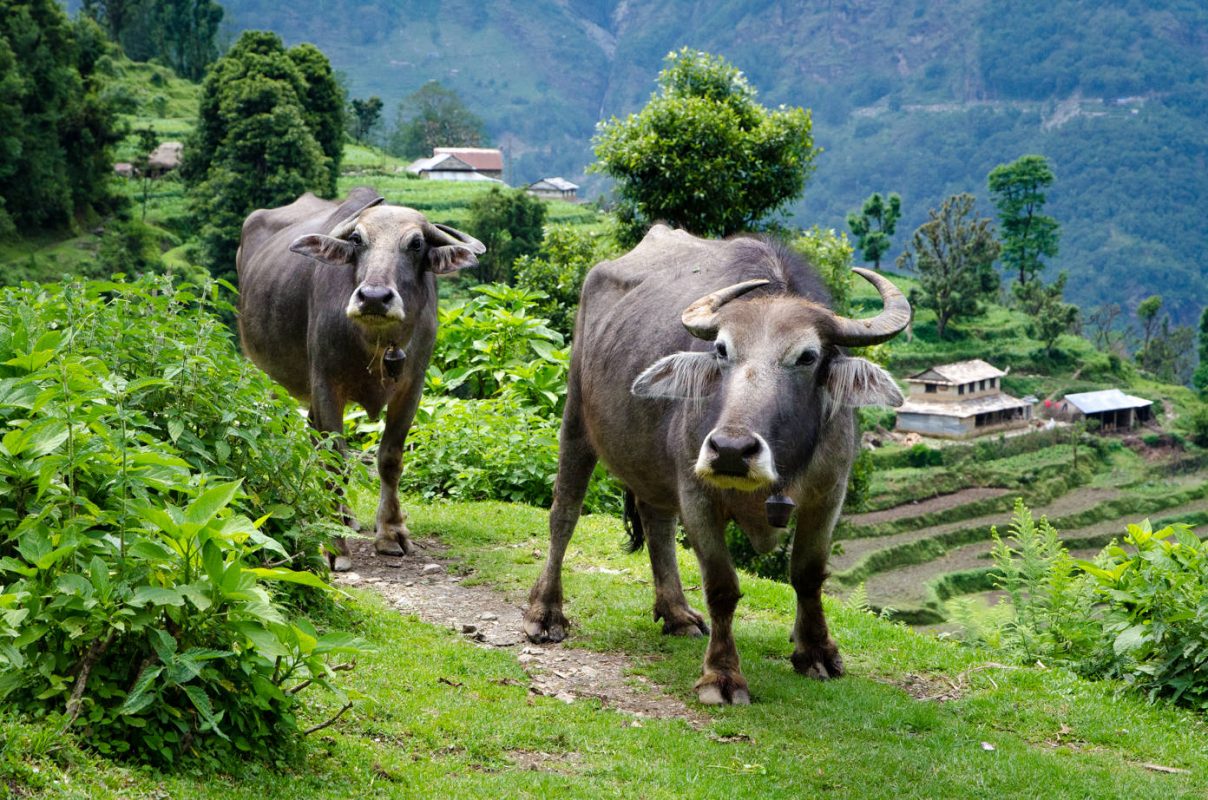
Buffalo
Rickety chairs, tv playing in the corner, horns blowing, headlights piercing dust and dark in equal measure. And a gigantic vat of boiling water out the front, in which dozens of the tiny love-dumplings were bobbing up and down, waiting to be fished out for our dining pleasure.
On their own they would have been delicious (the vegetable option in particular), but throw in a small bowl of spicy achaar, made with sesame, tomato and a generous dash of chilli, and you’ve got the perfect street food at less than a dollar a plate.

Mo:Mos!
It’s got the cool name. It’s got symmetry. It’s got the flavour.
It would normally be the last thing a traveller would ever want, but it’s even got a funky colon for goodness sake!
How this isn’t yet a national obsession back home I will never know 😀
“…it’s even got a funky colon…”
Alcohol

Millet Harvesting
What good is a plate full of dal-bhat or a mountain of Mo:Mos if you can’t wash it down with a glass of something alcoholic?
Whether it was in the middle of the city or up in the tea houses of the Himalaya, there was a surprising variety of drinks on offer. Some excellent, others downright nasty 😀
In descending order of alcoholic content…

Pouring Aila
Aila (60%) – Jetlag was a distant memory after throwing back a few shallow bowls of this fire water! In fact, it’s known colloquially by many as ‘wasa’, which translates to ‘medicine’ 😀 You can’t buy aila in shops, so your best bet is to find a restaurant specializing in Newari cuisine (the Newari are the caste that call the Kathmandu valley their home).
It’s a real show in itself watching the ladies serve this drink. They’ll start pouring into your bowl from down low, and then lift the jug high in the air, all while still pouring and without spilling a drop!
While rice is often used as the base grain for this liquor, I tried one made from millet, which resulted in a more earthy and rich depth of flavour. It was surprisingly good to be honest!
Raksi (22%) – Also based on either rice or millet, raksi is essentially a lower alcohol version of aila. In my opinion this allows the flavours to be more fully savoured and appreciated. Whether you like those musty flavours…well, that’s a different question altogether!
Smooth and even velvety in texture, it’s very similar to a Japanese sake and you don’t feel the alcohol at all. We came across this beverage in all the tea houses in the Himalaya. A great option on a cold night!

Mustang Coffee
Mustang Coffee (20%) – This is a real oddity and it took our hiking group a looong time to work out exactly what was in it. For the full story jump over here.
In short, it’s made from rice fried in butter, warm raksi, and coffee powder.
It’s worth trying for posterity’s sake. But you probably won’t want another.
Chaang (5%) – Of all the Nepali drinks that I tried, this was by far the biggest surprise packet. I’d never heard of it before, and anything unfamiliar yet resembling dairy always makes me nervous…

Chaang – It’s the glass of white liquid!
It only took one sip and I was transported…to South Korea of all places!! If you’ve ever tried the ‘rice beer’ called makgeolli you’ll know exactly what I’m talking about. The main difference being the Nepali chaang is a LOT tangier.
It was really refreshing on a hot day, and I encourage you to give it a try!
Tips for eating Nepalese food
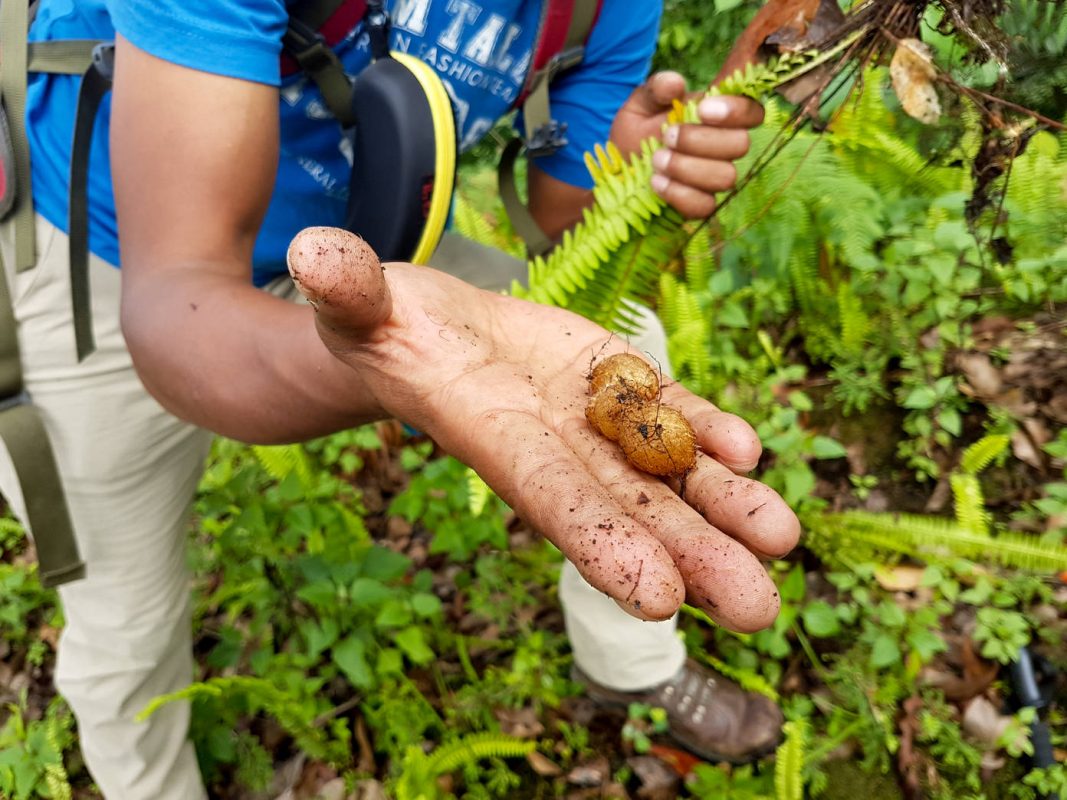
Water in the Wild
While half the fun of trying food in a foreign country is in the chaos of not knowing whether you’re committing a social faux pas, or simply making a goose of yourself, sometimes it’s handy to have a few tips under your belt…
Water – I can’t say this any more strongly; DON’T DRINK THE WATER! Bottled water, or water that’s been boiled for at least a few minutes will be fine, but anything else should be avoided like the plague. Fail in this, and you will GET the plague! It’s easy to forget this when you’re in the middle of your shower or teeth-brushing routine, so stay alert.
Food – If you’re keen on trying the street food, the normal rules apply. Try to eat with the locals and when/where it’s busy, as the high turnover means fresher ingredients.
Don’t eat food that you haven’t seen cooked or prepared freshly in front of you. Who knows how long it might have been sitting in the heat/dust/dirt?
You may think that eating in a restaurant is safer than street food…in many cases I would disagree. With a restaurant you can’t see what sort of hygiene is going on out the back whereas with a street stall everything is right in front of you. Within reason 😀
If all else fails, have a couple of packets of Immodium handy, or drop by one of the dozens of pharmacies that are everywhere in Kathmandu, selling medicines for a fraction of what you would pay back home for exactly the same product.
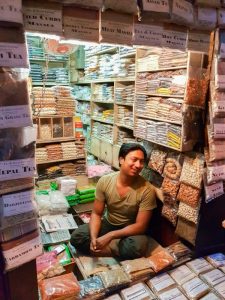
Spices
Etiquette – If you’re up for it, put your cutlery to the side and eat your dal-bhat like a local…with your hand! Your right hand that is. To use the left is a big no-no. I’m a lefty, so I stick with the cutlery option, saving my fellow diners from my very best Jackson Pollock impersonation.
The Breakfast Buffet – I’m not normally a fan of the hotel breakfast buffet, but in out of the way places it can sometimes be a good way of getting a taste of what the locals like to eat for breakfast, before venturing out into the streets. As already mentioned though, if it isn’t fresh, don’t eat it. Even if it’s in a hotel.
Try the Tea – There are so many tea options throughout Nepal, from masala to ginger-lemon, to regular black… Everyone drinks tea in Nepal so they REALLY know what they’re doing.
Cost at Altitude – As you would expect, both food and drink gets more expensive the higher up the Himalaya that you climb (as it’s normally some poor porter or mule that has to lug it up the mountainside). As an example, a 300mL bottle of Coke varied from less than a dollar in Kathmandu, up to more than $2 in Ghandruk (2000m). Boiled water can be purchased in the tea houses and is safe to drink.
Cost of Living – Nepal is one of the lowest cost destinations that I have experienced. Food, accommodation, transport, it’s all extremely good value. The only exception? Beer. It may be slightly cheaper than what you’re used to back home, but not by much.
Final thoughts on Nepalese food?
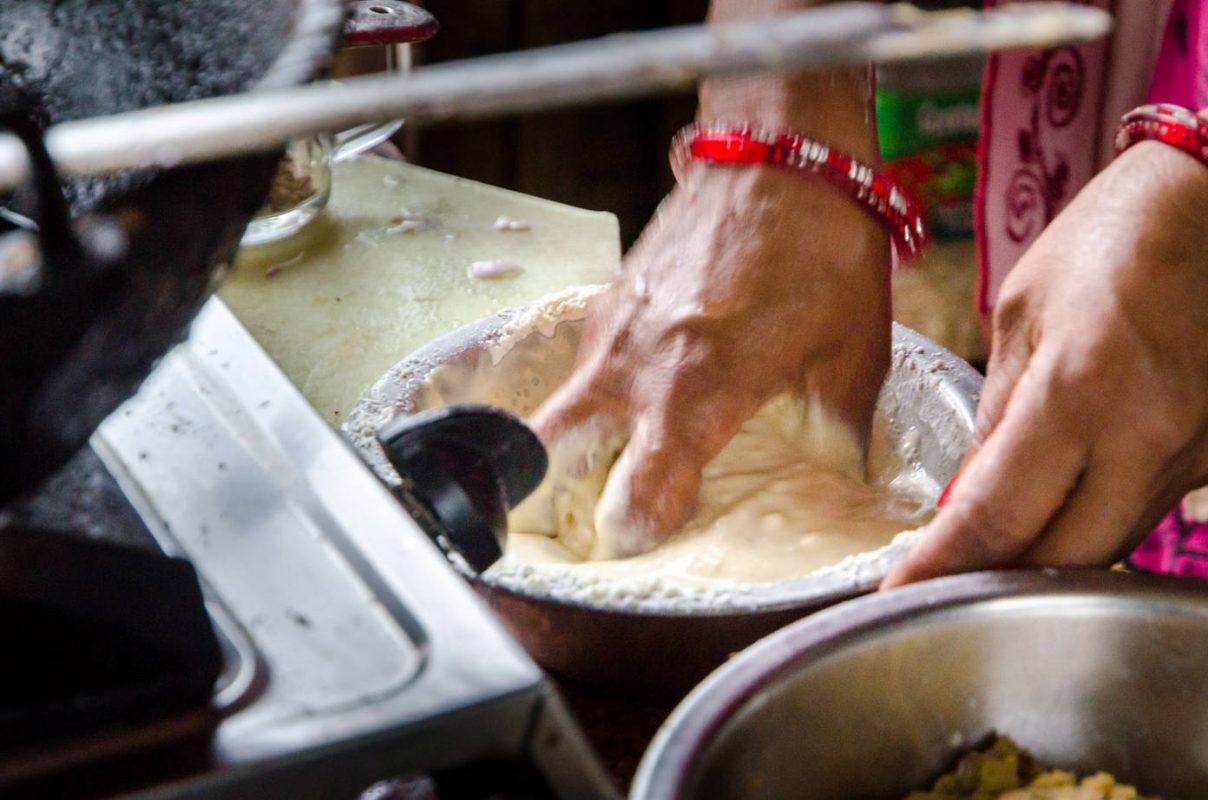 I arrived in Nepal knowing next to nothing, and departed so much richer for the experience, thirsting to know more about the things I had glimpsed my short time.
I arrived in Nepal knowing next to nothing, and departed so much richer for the experience, thirsting to know more about the things I had glimpsed my short time.
Sure, on the surface there are similarities to Indian cuisine, but it won’t take long and you’ll find yourself delving into a new world of history, culture and flavour that you never knew existed.
Two weeks was merely an appetizer, and it’s only now that I realise how many other traditional dishes there are that I never had the chance to try, hence the title of this article 😀 I can’t wait for the day we can both go back and immerse ourselves in the fantastic food, and friendly faces of Nepal!
As they say:
“Once is not enough. Twice is never boring!”
😀 😀 LIKE IT? PIN IT! 😀 😀
If you enjoyed this article on Nepal, you’ll love my adventures hiking in the foothills of the Himalaya!
Here’s a link:
In closing, I need to extend my sincerest thanks to the many businesses that came together to make the International Travel Bloggers and Media Conference a reality and sponsored so many bloggers like myself to make the journey to Nepal; the Nepal Chapter of PATA, the Nepal Tourism Board and Turkish Airlines.
As always, our opinions remain our own 🙂

